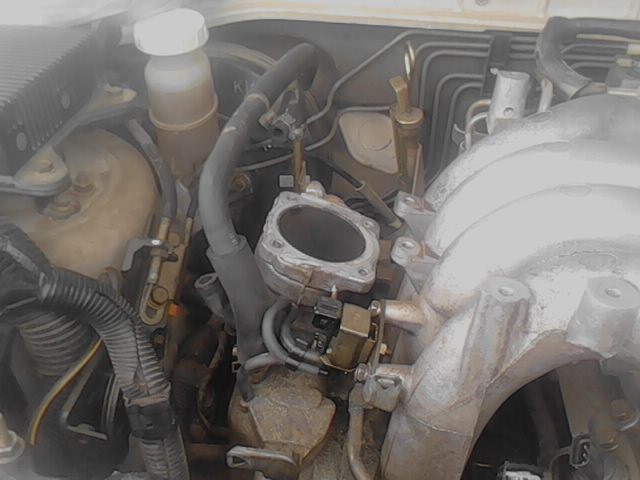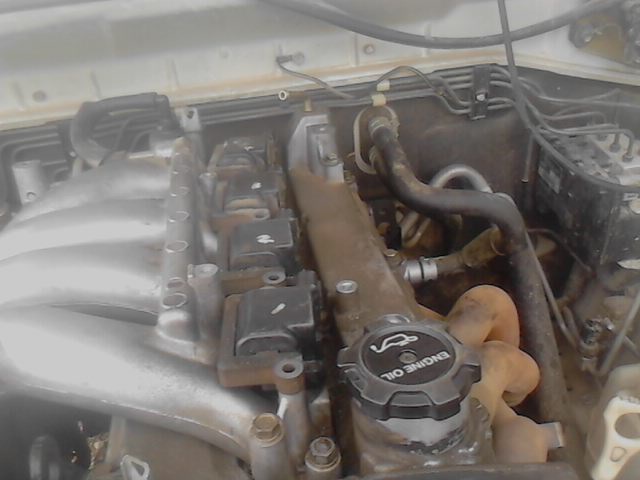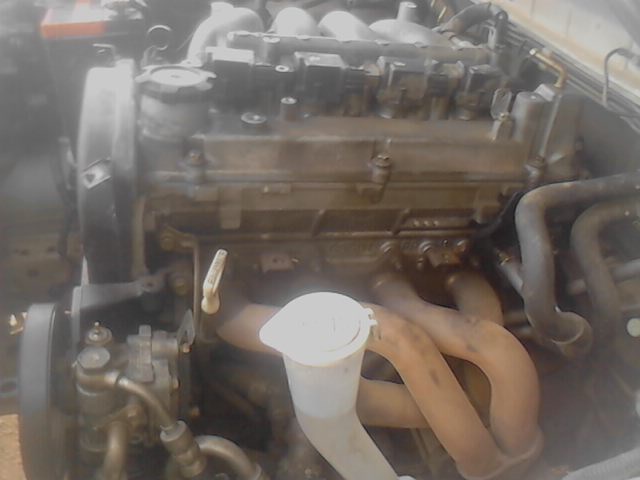Cylinder Head Gasket?
My IO just returned from getting some minor panel work.
Started it and noticed the engine light was still on. Increased idle and noticed some white smoke from the exhaust and also under the bonnet. Turned off the ignition and checked under the bonnet. Noticed coolant level low, raditator water level low and oil level low too. Topped-up all to recommended levels and decided to idle for 10 mins. Engine light still on, increased idle and still same status ie. smoke from exhaust and smoke coming-up from under the engine.
I'm not too sure of the symptons, but think it could be something in the engine, maybe cylinder head gasket. Can anyone please assist?
Any tips or advice, on
Any tips or advice, on current status?
Re-check of Head gasket symptons:
- Milky engine oil (looked under oil filler cap.),
- White smoke with a sweet odour smell,
- White smoke near exhaust manifold and cylinder head block, and
- White smoke coming out from exhaust once idle increased.
Current Status (as per workshop manual):
- Removed hoses to raditor,drained coolant and water, removed reserve coolant tank and also drained coolant from cylinder block.
- Removed radiator and found bottom R/H housing had been broken. Due to the damage, have to replace radiator.
- Removed air cleaner housing assembly and accessories.
- Removed resonance tank.
- Removed exhaust manifold cover.
- Removed ignition coil, yet to remove spark plugs (need spark plug removal tool).
- Removed engine assembly (electrical).
- Removed throttle body
Pictures:




Next:
- Removal of Intake Manifold,
- Removal of Fuel Pump and High Pressure Regulator,
- Removal of Water Bypass Pipe, and
- Removal of Timing Belt.
just keep on going
keep following the service manual, take care to set engine at TDC prior to removing belts and head - you can see the alignment marks on the crank pully and cam pulleys
re- cylinder head - you may find that the head is OK - worth getting a head replair place to inspect it to see if it has warped.
these modern engines are pretty easy to work on and forgiving, only thing you might need to watch is the rocker cover gaskets can be brittle and may need a slight smear of silicon gasket maker etc to get a good seal once reassembled.
STOP!!!
Before removing that cylinder head, you at least need to do a compression test.
Your symptoms indicate coolant is getting into the combustion chamber, and yes a leaking head gasket is a possibile cause, but it may not be the only one - a compression test will show low or mismatched number on the affected cylinders.
Coolant also flows through the throttle body, I've never taken it apart so I have no idea if that is a possible source, but I have seen other vehicles where coolant can enter through the intake.
You can do the compression test with the engine partially disassembled, as long as the timing belt has not been disturbed.
I also want to point out that TDC is, so to speak, not just Top Dead Center - each piston comes to TDC, twice in a cycle (two revolutions of the crankshaft), make sure the crank AND cam marks line up.
One last thing - the spark plug is a standard 16mm (5/8") spark plug socket, although you may find that some are too large to fit down into the plug well - a Stanley 86-380 will work.
Noted Fordem. I previously
Noted Fordem.
I previously had the issue of the white smoke from the exhaust, decided to take it to a local workshop and was advised that i had over-filled the oil. The mechanic drained all the oil and refilled to required levels and no more white smoke. Could this be a similar scenerio?
I resealed the broken end of my raditator with epox (metal and plastic glue), drained engine oil and put in a new oil filter. The AT fluid and coolant have also been drained and also the throttle body cleaned. Iam thinking of reinstalling radiator, air filter, refilling all fluids to there required levels and reinstalling throttle body, ignition coil, and resonance tank and then try starting engine to see if the symptons are still there, can i do this?
If symptons still exist i will then carry-out the compression test.
You could.
But honestly I would make a compression test a top priority item.
By the way - I personally would not rely too much on that repaired radiator, in my experience they don't hold for very long. I got my iO with a cracked previously repaired top tank that was still leaking, ground away all the epoxy and redid the repair - didn't get more than a few days before it started leaking again.
Exhaust Manifold
Exhaust Manifold Gasket!
Reinstalled all things taken out, plus new oil filter, and refilled all fluids to required levels. Started engine, moved selector lever through all positions and then to N, raced engine 3 times, checked to see if any leaks, no leaks. Noticed no more white smoke from the exhaust, however noticed white smoke from front L/H side of engine. Got someone else to race engine and there it was......smoke coming from the EXHAUST MANIFOLD. There must be a leak in the exhaust manifold gasket?
Followed service manual to remove exhaust manifold gasket, up to removing exhaust manifold. All bolts removed, however having problem trying to remove the first bolt, nearest to the power steering oil pump. Any tips to removing it without removing the power steering oil pump?
Sorry Fordem, will carry-out the compression test after checking the exhaust manifold gasket.
Re: radiator, thanks for advice. Here Port Moresby (PNG), there is now alot of imported japanese vehicles and the pajero io is one of them, i've noticed alot local workshops have got alot of the necessary service parts and the local wreckers have a couple of GDI engines in there yards. So, parts wise i could be able to pick up a used raditor if more drastic things happen to my current repaired one.
Need advice on the removal of above bolt, other than removing power steering oil pump!
removal of bolt
you will probably find that you will need to remove the accessory belt and loosen the pump bracket, pull the pump away from the engine to get clearance for the bolt.
on our MPI motors there is room but your DOHC motor is wider and would not have the clearance
Bad news! Removed exhaust
Bad news!
Removed exhaust manifold gasket and cleaned (see pics); reinstalled exhaust manifold, powersteering oil pump bracket, air cleaner and restarte engine. Let idle and after 5mins the white smoke resummed again, checked again and it was coming from near or below exhaust manifold. Noticed the very hot near exhaust manifold, raced engine 3 times and found white smoke and found watery oil fluid flushing out from exhaust. Poured water on the exhaust manifold to see how how it was and noticed it was very hot. Back to where i started, concerned about the head again. The red circled area is the area where the white scenty smoke is coming from.
As fordem pointed out, will carry-out compression test. Can someone, in laymans terms, tell me how to carry-out the compression pressure test?
The exhaust in normally quite hot.
I've measured in excess of 450*F with the engine at idle (IR temp gun).
To do a compression test you need the engine warm (not hot) and a fully charged battery, along with the compression tester, a length of tube - say a foot or so of 1/4" tubing, a squirt type oil can with engine oil and a spark plug wrench.
Start by disconnecting the crank position sensor (the connector is half way down the timing belt covers on the front of the engine - this disables the fuel injection & spark.
Remove the intake plenum that goes over the engine, remove all four coils and spark plugs.
Wedge the throttle plate fully open
Screw the compression tester into the #1 plug hole and crank the engine over - the gauge needle will jump on every compression stroke going a little higher each time and reach a "peak" around the third or fourth jump - record that reading as the dry number for this cylinder and repeat this for each cylinder
After doing all four cylinders, use the 1/4" tubing and the oil can to squirt about a teaspoon full of oil in the #1 plug hole - the tube is needed to get the oil into the combustion chamber, and not just into the plug well - reconnect the compression tester and test again - record this reading as the wet number for this cylinder and repeat for each cylinder.
I do not remember off the top of my head what the compression numbers should be for the GDI engine but they are fairly high - 190 psi or possibly higher - but what is more important is the differences between wet & dry numbers, and between the different cylinders - if you see one or maybe two cylinders significantly lower than the others, that would be a bad sign, if the wet numbers are significantly higher than the dry ones, that is usually an indication of worn rings.
Post the numbers you get and let's see what they look like.
Will carry-out the
Will carry-out the compression test over the weekend.
This morning i started engine and let idle for 30mins to check the temp and idle rpm, here is waht i found:
Engine Temp - approx halfway between cool and hot (stable after thirty minutes of idling)
Idling RPM - approx 500
Drove engine a short distance and stopped and let it idle, no change in temp. Raced engine and found small amounts of water being sprayed out from exhaust (no signs of oil). Rechecked engine temp, stable. Looked under engine and A/T to see if any leaks and found water leaking above the A/T. Close invesigation found it was leaking from hose not connected, above the front end of the A/T (see below A/T oil cooler pic for the area). Could not get a pic of the hose, but the fluid leaking was water. I'm guessing the hose must be either the feed or return hose for the A/T oil cooler.
Could this be the reason for the small amounts of water being sprayed out from the exhaust, when i raced the engine? and also, the fumes from the water evaporating under the engine and rising-out from the front L/H side of the engine? Could the sweet scent of the fumes be the evaporating A/T fluid/Coolant and water?
The hoses circled are the A/T cooler circuit.
There is no water flowing through those hoses - they are a part of the A/T cooler circuit and take ATF to & from the cooler in the radiator bottom tank - if one is disconnected and the engine started, the transmission will pump all the ATF out within 3~4 minutes. Thoses hoses are also low down and on the right side of the engine, I don't see a leak there making it into the exhaust on the left side, so steam/smoke from there would be unrelated. If you are seeing water in this area, it is possible that a leak in the throttle body coolant circuit above can drip down.
Coolant does have a sweetish smell, and I should point out the cylinder head outlet for the heater circuit is just over the exhaust manifold - there are several fittings for temp gauges and a leak there would/could fall on to the exhaust and produce steam under the hood, although I don't see how it could/would get into the exhaust itself.


pop a plug
pop out the spark plugs and have a look inside with a torch.
sounds bad but not death-bad. head gasgets are tricky but wasy enough to DIY
.